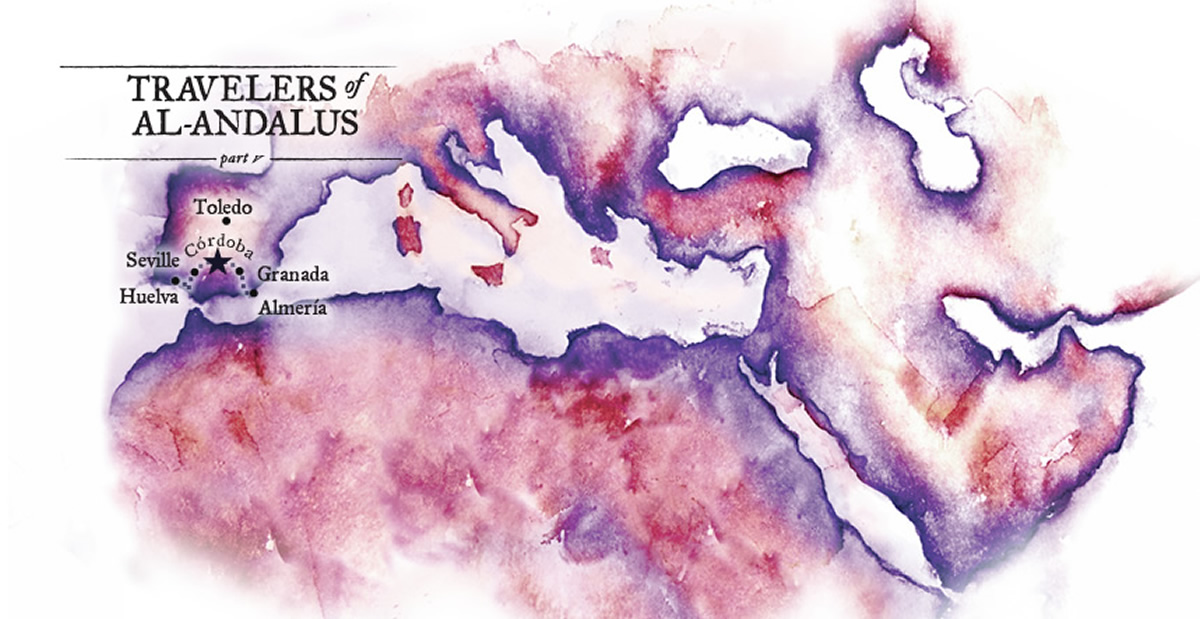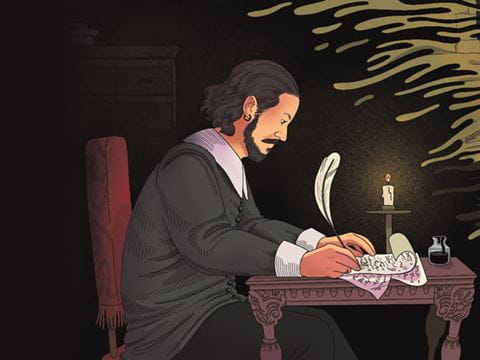
Travelers of Al-Andalus, Part V: Ibn Hazm’s Journeys of Exile and Love
Socially acerbic, survivor of 11th-century politics that drove him from three homes, Ibn Hazm wrote prolifically on many subjects, but he is remembered most of all for his bittersweet classic, Tawq al-Hamama, or The Ring of the Dove.

Some travel more with their feet and others travel more in their hearts. The names of some are known in foreign lands because they themselves have gone there, while others become famous abroad because their works precede them. Some reputations are forceful, and some are gentle. But those people whose legacies journey farthest often are those who write not of conflict, but of love.
For Abu Muhammad Ali ibn Hazm, topics of the heart examined from all possible vantage points—from moral philosophy to social psychology, from the most ethereal matters of the spirit to the most practical ones of the body, and, in religious terms, from the sacred to the profane—engraved his stamp on both Arabic and Western literary traditions far from his own life and times in 11th-century Al-Andalus.
His most important book is Tawq al-Hamama (The Ring of the Dove). It is the one Arabic work most cited alongside the Western canon on like subject matter—the Greek philosopher Plato, the Roman poet Ovid, troubadours in medieval France who strummed their lyrics on the lute (descended from the Arab ‘ud) and also, one might argue, the Beatles in “I Want to Hold Your Hand,” Elvis Presley in “Don’t Be Cruel (To a Heart That’s True)” and singers of countless similar boy-wants-girl pop confections.

Historians recognize that Al-Andalus served as a bridge to Europe of the literary form known as the muwashshah, or the rhymed strophic poetry with a refrain. The word came from the Arabic root meaning cummerbund, as if each stanza is “belted” by the repeating verse. They were often set to the musical accompaniment of lute, tambourine and hand drum—the ideal instruments for a minstrel trailing his royal sovereign or the ladies of the court. But from where came love as the subject of a song?
For this, medieval Europe looked to the Arabic translators in Al-Andalus as well as the Arab East, and to the Christian court in Toledo, where Arabic was still widely spoken. All helped transmit back to Western languages what the Arabs had previously translated from Latin and Greek. While most of these texts were scientific and analytical, there was also a keen interest in what might be called the philosophy of life—and they returned to Europe those ideas that classical writers had expounded about the nature of the human heart.
As Plato has Phaedrus say in his eponymous dialogue, “My tale, Socrates, is one of your sort, for love was the theme that occupied us—but love after a fashion.” Their conversation continues on the subjects of soulful, mad and divine love. Or as Ovid put it in the opening lines of his Art of Love, written with the same pedagogical purpose: “If there be anyone among you who is ignorant of the art of loving, let him read this poem and, having read it and acquired the knowledge it contains, let him address himself to Cupid.”
As a similar guide to the heart from an Arab perspective, Ibn Hazm praised the supremacy of requited love and rejected the remote and unattainable love often depicted by pre-Islamic poets, that of a woman whose only traces are found, for instance, in the dead ashes of her abandoned campfire. When the sixth-century poet Imru al-Qays wrote, “Oh my friends / Let us stop and weep over the remembrance of my beloved / Here was her abode on the edge of the sandy desert,” Ibn Hazm responded, “Spare me those tales of the Bedouin … their ways are not our ways … it is not my habit to wear out anyone’s riding beast but my own.”
Indeed he explicitly rejected the imagery of the desert, and in The Ring of the Dove’s introductory poem, he directly addressed his beloved:
The passions most men boast them of
Are like a desert’s noontide haze:
I love thee with a constant love
Unwithering through all my days.

Ibn Hazm was born in Córdoba in the year 994 to the Bani Hazm, a large, Arabized family of Hispanic origin. His grandfather had long ago abandoned the family farm near Huelva in order to improve his fortune by serving in the Umayyad court, then at the apex of its magnificence in Córdoba. Ibn Hazm’s father, Ahmad, was a man of letters who was also skilled in navigating the political affairs of Caliph Hisham ii, and he attained the office of vizier.
The caliph awarded Ahmad with privileges of luxury and wealth, and he allowed the family to move closer to the court in the noble city of Madinat al-Zahra, on the outskirts of Córdoba. There, Ibn Hazm spent his childhood in the haram among the women, where he observed and learned from them in silence. This experience helped him develop a sensitive understanding of the feminine perspective on life that was to become so important in all his literary and philosophical works.
As a boy, Ibn Hazm was said to have been especially impressionable, clever but prone to melancholy, educated in the high tradition that included Greek sciences and readings of classical Arab authors. In those years he shared company with a group of intellectuals who belonged to the aristocracy, among whom he would later seek protection from political persecution, and with whom he would ceaselessly squabble over arcane matters literary and theological.
It was until the year 1008 that the imperial capital at Córdoba enjoyed a splendor built on the strength of the Umayyad caliphs. However, after dynastic upheavals and family conspiracies, the political situation turned turbulent. Revolts and internal struggles brought on a long series of betrayals, murders, dismissals and rebellions, sudden enthronements followed by usurpations and exiles. All marked a decline that resulted in the abolition of the caliphate in 1031. In all this, Ibn Hazm’s father was dismissed from his post, his privileges began to vanish, and he fell from favor. Chaos reached its peak in May 1013. Ibn Hazm was about 20 by then. Córdoba fell into the hands of an invading Berber army from North Africa. The city was plundered, its streets littered with corpses, its gardens and palaces reduced to ashes. The Bani Hazm home was demolished, its extended family members dispersed and chased from town, and the young Ibn Hazm, now sunk into more than a typical adolescent depression, went into self-imposed exile to Almería.

Almería, it turned out, was no safe haven, and there he was arrested and sent into involuntary exile, first in the hamlet of Aznalcázar near Seville, then in Játiva, Valencia—which happened to be the center of papermaking in Al-Andalus, which may have nudged him to first pick up the pen. Later he was to return to his family’s ancestral farm near Huelva, and there he died at age 70 in 1064.
Although the open wound in Ibn Hazm’s temperament never healed, it did give him the impulse in the year 1022 to write about—of all things!—love, a much more refined and multifaceted emotion than the rancor he must have felt. The Ring of the Dove, an exquisitely composed and maturely imagined treatise on the act of loving and being loved, was composed by a 28-year-old who by all accounts had not yet tasted any of that.
What he wrote in following years—if his son Abu Rafi can be believed—comprised more than 80,000 pages in some 400 works on topics such as theology, law and religious polemic (subjects far in spirit from where he first began), and it was all torched on the order of Abbad ii Al-Mu’tadid, the petty ruler of the kingdom of Seville that took shape following the breakup of the Caliphate. Ibn Hazm’s defiant answer to this was, “Even though you might burn paper, you will not burn what is written upon it, since that remains in my heart and in my mind.”
Literary scholars Ramón Menéndez-Pidal, María Rosa Menocal and others believe that Arabic literature has been until recently an underestimated source for much of medieval European belles-lettres. Attraction, temperance, forbearance: such subjects can be found in the philosophical tracts of Ibn Rushd (Averroës), who lived in Córdoba a century after Ibn Hazm. In following centuries, it is not known when or if the West ever became enlightened by the Tunisian Shihab al-Din al-Tifashi’s manual Delight of Hearts About What Will Never Be Found in Books, or from the Arab East by Ibn Qayyim al-Jawziyya’s Meadow of Lovers and Diversion of the Infatuated and Ibn al-Jawzi’s Condemnation of Desire.
Ibn Hazm’s work stands above because of its fine balance of rumination and reflection interspersed with his poems and personal history. Some of his most engaging anecdotes are based on his own experience, and they begin with such lines as, “Once when I was seated in Almería,” or “I knew a young man who,” or “Writing this has put me in mind of a certain day when,” or, as an example of his wide range of informants, “A woman in whom I have confidence once told me.”
According to The Ring’s English translator A.J. Arberry, it shows “a perfect blend of sacred learning and profane delectation.” He goes on to say, “Ibn Hazm is surprisingly free of pedantry; it is doubtful whether any other Arab writer so well qualified as he would have resisted the temptation to enumerate all that earlier scholars had said on the derivation of the Arabic word for passion.”

Ibn Hazm’s dedicatory preface, addressed to an unnamed friend but probably his fellow poet Ibn Shuhayd, lays it out: “You charged me—may God exalt you!—to compose for you an essay describing Love, wherein I should set forth its various meanings, its causes and accidents, and what happens in it and to it.” In this, his purpose was less to instruct and more to warn. Among its 29 chapter headings, one can read: “Of the Slanderer,” “Of Wasting Away,” “Of Betrayal,” “Of the Vileness of Sinning” and “Of the Reproacher”—all showing just how cautionary was his tale.
Yet there were also joyful accounts of the times when love goes not wrong but right. “I never saw any amorous couple,” he wrote in the chapter “Of Contentment,” “who did not exchange locks of hair, perfumed with ambergris and sprinkled with rosewater, done up at the roots with mastica or clarified white wax, and wrapped about in ribbons of embroidered cloth, silk or the like, to serve as a souvenir when they are separated.”
The Ring’s many poems, which were heavily excised in the one remaining manuscript that was copied three centuries after its original composition and now resides at the University of Leiden, are written as commentary on the life lessons taught in its more discursive prose sections. Arberry has put them into rhyming quatrains that seem to jump off the page as love lyrics wanting to be sung. This one comes from the chapter “Of Allusion by Words,” about how deeply speech can sting the heart:
Harsh words of bitter blame
And false complaining came
From one most cruel, who
Was judge, and plaintiff too!
She laid her nameless charge
Before the world at large,
But none knew her intent
Save him, whose hurt she meant.
It is almost as if the troubadour Marcabru, who lived in Gascogne in southwestern France in the following century and sang most famously about the alleged perfidies of women, had first read The Ring of the Dove.
By the fountain of the orchard,
where the grass is green, near the shore …
I found, alone, without companion,
she who doesn’t want my happiness.
Paul McCartney had not yet been disappointed in love (as Ibn Hazm predicted he inevitably would be) when he sang, “Oh please, say to me / You’ll let me be your man / And please, say to me / You’ll let me hold your hand.” But the Andalusian could have also warned that stony silence, even more than harsh words, can pierce the heart of a true but unrequited lover, as Elvis Presley learned to his own sorrow:
You know I can be found,
sitting home all alone,
If you can’t come around,
at least please telephone.
Don’t be cruel to a heart that’s true.
To return from the recording studio back to the 11th century, Ibn Hazm counseled firmly that neither boy nor girl “come around” to their beloved, and The Ring is suffused with advice for continence and separation. Even as he quoted a hadith (saying) of the Prophet Muhammad, “Let your souls relax from time to time, otherwise they are apt to rust in the same way that metal rusts,” he also stated a higher purpose: “I have planned the matter thus so that the conclusion of our exposition and the end of our discussion may be an exhortation to obedience to Almighty God, and a recommendation to do good and to eschew evil; which last commandment is indeed a duty imposed upon all believers.”
But whether good and evil can so easily be discerned between lovers, that is the eternal question Ibn Hazm left hanging. And it remains so, in varying and inverse proportions of the two, in almost every love song ever since written.
“Travelers of Al-Andalus” is a six-part series selected and adapted from the original 41-part series “El Viajero Histórico,” an idea and production by Ana Carreño Leyva in El Legado Andalusí: Una Nueva Sociedad Mediterránea, the magazine of the Andalusian public foundation El Legado Andalusí, based in Granada, Spain, from 1990 through 2010. The basis of this article appeared in issue number 19, titled “Ibn Hazm de Córdoba,” by Magdalena Lasala.
You may also be interested in...

See How Researcher Zainab Bahrani Rethinks Narrative of Ancient Art
History
Arts
Zainab Bahrani of Columbia University photographs ancient statues and reliefs carved into the rocks of remote Iraq to create a database for conservators and scholars. The effort is “decentering Europe from histories of art and histories of archaeology.”
Stratford to Jordan: Shakespeare’s Echoes of the Arab World
Arts
History
Shakespeare’s works are woven into the cultural fabric of the Arab world, but so, too, were his plays shaped in part by Islamic storytelling traditions and political realities of his day.
“Old Bridge” Story Inspires Lessons in Writing and Community History
History